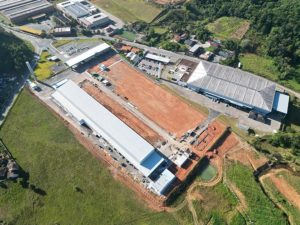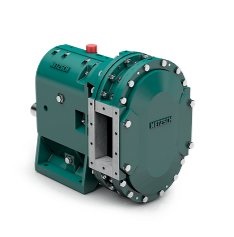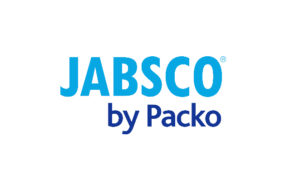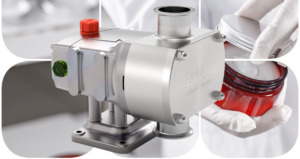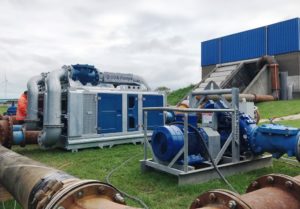From Inflow to Sludge Treatment
Water and environmental protection specifications, efficiency and economic questions have resulted in sewage plant processes becoming very complex. Media of different viscosities from untreated waste water up to thickened sludge must be handled. In order to ensure smooth conveyance at all stages, different types of pumps from the company Netzsch Pumpen & Systeme GmbH were combined in a Swabian sewage plant.
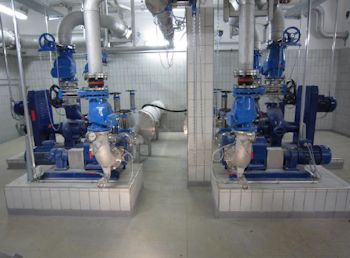
Different types of pumps were combined, depending on the medium, pressure requirement and space available (Image: Netzsch Pumpen & Systeme GmbH)
The pumps were especially adapted to the demanding operating conditions. The specific design was selected for the corresponding medium and pressure required and also with a view to the existing installation space. Thus, in conjunction with the coarse material macerators of the company, high operating safety and reliability from one source was attained.
Waste water presents a particular challenge to the conveying systems: The composition changes and, in particular, the ratio of coarse materials, whereby, congestion of the material and increased wear can occur. Due to the risk of blockage at different locations – for example, at the infeed or at the sludge presses – the community had M-Ovas cutting plate grinders installed upstream of the Netzsch pumps, that finely cut up any coarse material so that the conveying sequence is no longer impaired. The macerators are designed so that they can be installed directly in the pipe line. An integrated separator collects foreign matter, such as stones, that can then be removed through a separate cleaning aperture. The actual medium is ground in a cutting unit using hard metal blades. A flywheel assists the drive, thus reducing the energy required. The complete system, including the drive inclined upwards is of a very compact design, so that it only requires a little space. This was all the more important because the space for installation available in the machine rooms was very limited.
Space-saving rotary lobe pumps for transporting waste water
For this reason, the rotary lobe pumps type Tornado were also selected for the transportation of waste water from the infeed and between the different clarification and cleaning stages. These are very short in their conventional T1 design. It features a high power density and depending on the design, up to 1000 m³/h at up to 8 bar can be conveyed. Particular restricted conditions comply with the T2 design, where the motor has been displaced above the pump chamber using a bracket resulting in one of the shortest pumps on the market. For the communal sewage plant in which only 5 to 13 m³/h of waste water at a viscosity of 100 to 200 mPas and 2 bar pressure must be pumped, a relatively small model is sufficient.
In addition, the spatial isolation of pump and gearbox protects the Tornado pumps against damage and operation shutdowns due to leakage of the medium. Maintenance and cleaning tasks are also carried out with ease: The large front cover can be easily removed, so free access to all wetted parts is given. The straight rotary lobes can be installed and removed very easily and separately from one another. The pumps are very robustly designed and, due to their large free ball passage and correspondingly large foreign matters or content material can be conveyed with no problem.
Pressure-stable conveyance of thick sludge using progressing cavity pumps
In contrast, handling the thickened sludge resulting from the clarification process presents a problem. This sludge contains approximately eight to eleven percent of dry matter content and, due to its composition, no longer features linear flow characteristics similar to water. However, in order to ensure consistent conveying at 4 bar, Nemo progressing cavity pumps have been installed at the appropriate locations in the process, for example, for transporting to and from the digestion tank.
The conveyance principle is based on a rotor which turns in an oscillating motion within a fixed stator. The result is – dependent on the geometry pairing between rotor and stator – conveying chambers in which the medium is uniformly moved from the suction to the discharge side by the rotary motion. Thereby, pressure and conveying volume remain stable, independent of the consistency or viscosity of the medium. Also, very few shear forces or pulsation occurs that could influence the medium and make conveying difficult. Whilst filling the chambers with the high viscosity medium, the stator inlet bevelled also assists. As required, the coupling rod can also be equipped with a feeding screw. In this manner, a throughput of up to 400 m³/h at up to 48 bar can be realized.
Overall conveying concept considering medium, pressure and structural circumstances
Because thickened sludge is partly abrasive, particularly resistant materials are used in the sewage plant: The housing has been manufactured from grey cast iron, the coupling rod from chromed steel. In addition, the rotors installed are made from hardened chromed steel. Thereby, the progressing cavity pumps are ideally adapted to their demanding field of application. In addition, in order to prevent possible blockages, M-Ovas macerators have also been installed at critical locations upstream of these pumps.
For the model Nemo BY used, the motor is flanged in block design to save space, however, the pumps require more space than, for example, rotary lobe pumps. Thus, in close coordination with the operating company, the specialists from Netzsch investigated the sewage plant and, taking into consideration the medium characteristics, pressure requirements and space available, proposed which technology could be utilized at which location. The final result was a comprehensive conveying concept,starting from the infeed, through the sludge treatment up to the receiving water and transportation of the dewatered sludge which has now been in successful operation for more than a year.

